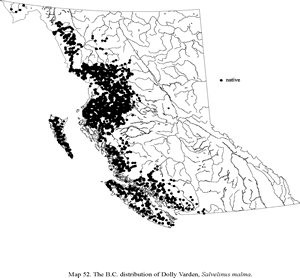Dorsal spines (total): 0; Dorsal soft rays (total): 10 - 16; Anal spines: 0; Anal soft rays: 10 - 15. Body elongate, somewhat rounded, greatest body depth below dorsal fin. Head rather long. Pelvic fins with free-tipped fleshy appendage above its insertion. Caudal emarginate (Ref. 27547). Color varies with size, locality and habitat. Sea-run adults with back, upper head, and upper sides dark blue, the sides silvery to white. In freshwater populations, the back and upper sides are olive green to brown, the sides a paler color but bright red in spawning fish and at all times in some areas of Alaska, the underside white to dusky. The dorsal surface are marked with yellow, orange or red spots, more numerous and those along the lateral line smaller, than in arctic char. Spawning males, especially of anadromous populations, turn red on the ventral surface and tip of snout. The lower jaw, operculum and parts of the head are black, the back and sides turn olive-brown. The spots become more vivid orange-red, the pectoral and anal fins red-black with a white leading edge, the snout thickens and the lower jaw turns up. Females change less.
Source: FishBase. Page, L.M. and B.M. Burr 1991 A field guide to freshwater fishes of North America north of Mexico. Houghton Mifflin Company, Boston. 432 p
